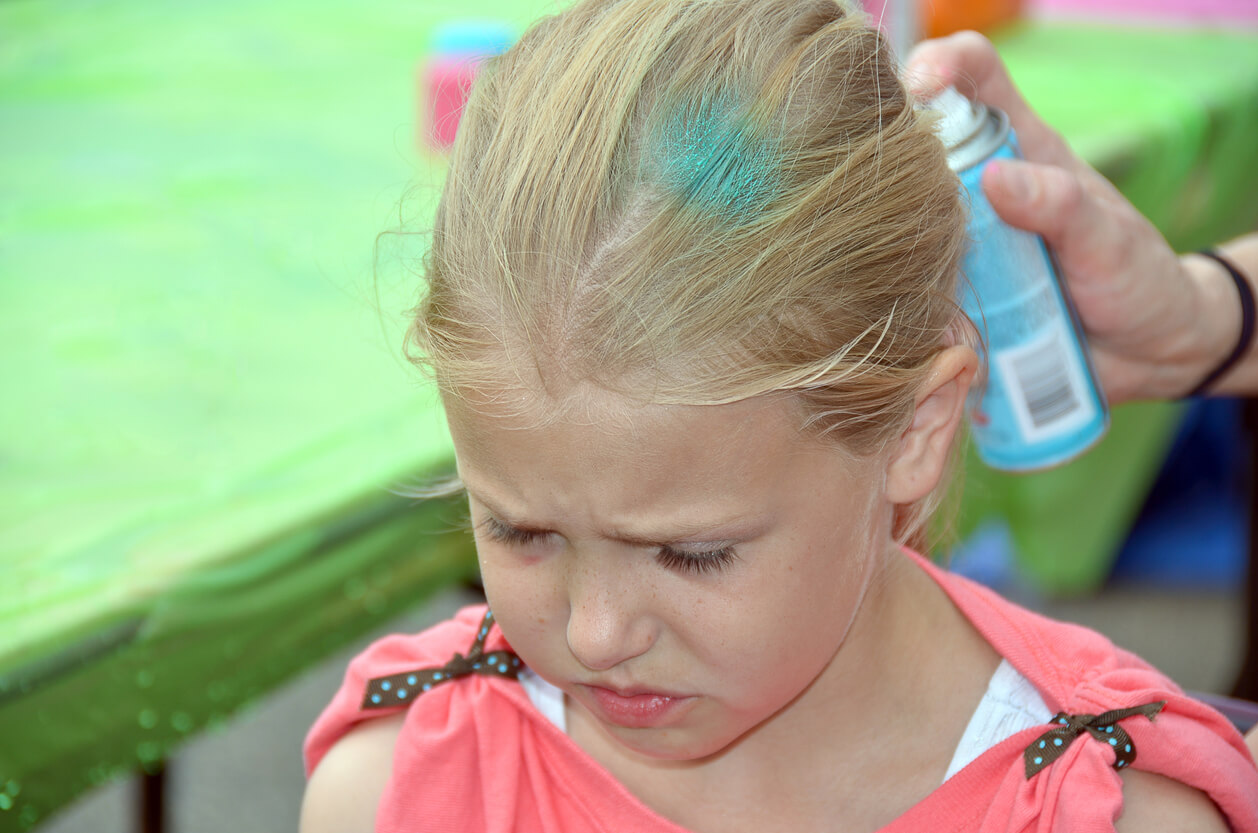What Do I Do if My Child Wants to Color Their Hair?


Written and verified by the psychologist Maria Fátima Seppi Vinuales
Idols, family members, fashion, and friends: Many times, these people influence children’s desire to want to change the way they look. “I want the hair color my favorite singer has” or “I want my best friend’s haircut”. Some of these changes, like having bangs, are no big deal, while others, like using hair dye, invite us to think twice. So what can you do if your child wants to color their hair? We’ll tell you in the following article.
What to do if your child wants to color their hair
As a parent, you’ve probably been surprised more than once by one of your child’s “firsts”. For example, the first time they said a bad word, showed curiosity about a subject, or the first time they asked you to let them do something on their own. Also, one of those times might be when they told you they wanted to color their hair. Perhaps, you already have an opinion about it. But, when in doubt, it’s always good to consult and inform yourself.
First of all, it’s good to know that children’s hair, like the rest of their body, grows stronger as they develop. That’s why, in the beginning, you may perceive that the hair is a bit more delicate. This’s why the application of hair dyes, especially perms and bleaching treatments, isn’t recommended.
Also, keep in mind that, because it’s not a product suitable for early ages, it may cause some adverse reactions. These can range from allergies and skin irritation to burning eyes and even an itchy throat.
You may be interested in: Are Hair Dyes for Children Safe?

Recommendations to keep in mind when your child wants to color their hair
Here are some suggestions for responding to your child’s request to color their hair.
If you don’t give them permission…
If you refuse to give your child permission to color their hair, you can consider these points:
- Give a valid reason: Even though there are products that aren’t permanent, if you decide that it’s not appropriate for your child to wear hair dye, it’s important to explain the reasons why. For example, you can talk about the fragility of the hair and comment that there are activities that are better done later.
- Avoid phrases that show imposition, such as “You have to obey me because I’m your mother” or “Stop protesting and just do what I say”, among others. These forms, far from being explanatory and facilitating the child’s understanding, are more about authority than education. Especially if they see that you dye your own hair, because, if you don’t give them a coherent explanation, they’ll think that it’s just a whim.
- Use simple arguments: To explain the reasons for your decision, you can use language adapted to the age of the child. This way, it’ll be much easier for them to understand your refusal. At the same time, it’s worth mentioning the temporary nature of this decision: Saying no now doesn’t mean that you’ll never let them do it. At a young age, it’s possible that the desire to color their hair is more related to role-playing and exploration. Therefore, you can suggest an alternative, such as wearing a wig.
If you grant permission

If you’ve decided that it’s okay for your child to be able to color their hair, then you can take the following precautions:
- Don’t choose permanent dyes: You can go for a new look with other products that are washable and don’t cause harmful effects on the hair.
- Provide information: You should tell your child about the procedure and the effects it could have on their hair. Also, give them instructions on hair care and hair recovery. In this way, your child will also be able to decide whether to go ahead with their request, while you teach them to be responsible for their choices.
- Remove the product quickly: Even if it’s a superficial dye, it’s advisable to remove it from the hair the same day it’s applied. When doing so, be careful that it doesn’t come into contact with their eyes.
- Make sure that there’s no allergic reaction: It’s important to start by working on a small, limited area. Apply the product and then take a few minutes to evaluate what happens.
- Think about a gradual change: It’s important that you inform them about the subject and perhaps recommend a gradual change. Many children and young people have ever-changing tastes and interests, so the look they like today will soon change. So, for example, you can suggest that instead of changing from a dark shade to a platinum blonde, they can try some highlights, or some shade in between.
You may be interested in: Nail Polish on Children: Is It Safe?
Knowledge-based decisions
If your child wants to paint their hair, no matter what decision you make, it’s always important to put the request in context. Why do they want to do it? Sometimes, it’s simply a desire to explore and experience a change. In other cases, perhaps more in adolescence, sometimes it’s a group phenomenon, to “be like others”. Or, perhaps your child is uncomfortable with their image.
By approaching and talking to your child, you’ll be able to get to know them better and understand their motivation. This way, you’ll also be able to offer your advice on what you think is best.
Idols, family members, fashion, and friends: Many times, these people influence children’s desire to want to change the way they look. “I want the hair color my favorite singer has” or “I want my best friend’s haircut”. Some of these changes, like having bangs, are no big deal, while others, like using hair dye, invite us to think twice. So what can you do if your child wants to color their hair? We’ll tell you in the following article.
What to do if your child wants to color their hair
As a parent, you’ve probably been surprised more than once by one of your child’s “firsts”. For example, the first time they said a bad word, showed curiosity about a subject, or the first time they asked you to let them do something on their own. Also, one of those times might be when they told you they wanted to color their hair. Perhaps, you already have an opinion about it. But, when in doubt, it’s always good to consult and inform yourself.
First of all, it’s good to know that children’s hair, like the rest of their body, grows stronger as they develop. That’s why, in the beginning, you may perceive that the hair is a bit more delicate. This’s why the application of hair dyes, especially perms and bleaching treatments, isn’t recommended.
Also, keep in mind that, because it’s not a product suitable for early ages, it may cause some adverse reactions. These can range from allergies and skin irritation to burning eyes and even an itchy throat.
You may be interested in: Are Hair Dyes for Children Safe?

Recommendations to keep in mind when your child wants to color their hair
Here are some suggestions for responding to your child’s request to color their hair.
If you don’t give them permission…
If you refuse to give your child permission to color their hair, you can consider these points:
- Give a valid reason: Even though there are products that aren’t permanent, if you decide that it’s not appropriate for your child to wear hair dye, it’s important to explain the reasons why. For example, you can talk about the fragility of the hair and comment that there are activities that are better done later.
- Avoid phrases that show imposition, such as “You have to obey me because I’m your mother” or “Stop protesting and just do what I say”, among others. These forms, far from being explanatory and facilitating the child’s understanding, are more about authority than education. Especially if they see that you dye your own hair, because, if you don’t give them a coherent explanation, they’ll think that it’s just a whim.
- Use simple arguments: To explain the reasons for your decision, you can use language adapted to the age of the child. This way, it’ll be much easier for them to understand your refusal. At the same time, it’s worth mentioning the temporary nature of this decision: Saying no now doesn’t mean that you’ll never let them do it. At a young age, it’s possible that the desire to color their hair is more related to role-playing and exploration. Therefore, you can suggest an alternative, such as wearing a wig.
If you grant permission

If you’ve decided that it’s okay for your child to be able to color their hair, then you can take the following precautions:
- Don’t choose permanent dyes: You can go for a new look with other products that are washable and don’t cause harmful effects on the hair.
- Provide information: You should tell your child about the procedure and the effects it could have on their hair. Also, give them instructions on hair care and hair recovery. In this way, your child will also be able to decide whether to go ahead with their request, while you teach them to be responsible for their choices.
- Remove the product quickly: Even if it’s a superficial dye, it’s advisable to remove it from the hair the same day it’s applied. When doing so, be careful that it doesn’t come into contact with their eyes.
- Make sure that there’s no allergic reaction: It’s important to start by working on a small, limited area. Apply the product and then take a few minutes to evaluate what happens.
- Think about a gradual change: It’s important that you inform them about the subject and perhaps recommend a gradual change. Many children and young people have ever-changing tastes and interests, so the look they like today will soon change. So, for example, you can suggest that instead of changing from a dark shade to a platinum blonde, they can try some highlights, or some shade in between.
You may be interested in: Nail Polish on Children: Is It Safe?
Knowledge-based decisions
If your child wants to paint their hair, no matter what decision you make, it’s always important to put the request in context. Why do they want to do it? Sometimes, it’s simply a desire to explore and experience a change. In other cases, perhaps more in adolescence, sometimes it’s a group phenomenon, to “be like others”. Or, perhaps your child is uncomfortable with their image.
By approaching and talking to your child, you’ll be able to get to know them better and understand their motivation. This way, you’ll also be able to offer your advice on what you think is best.
All cited sources were thoroughly reviewed by our team to ensure their quality, reliability, currency, and validity. The bibliography of this article was considered reliable and of academic or scientific accuracy.
- Benaiges,Aurora (2007). Tintes capilares. Evolución histórica y situación actual. Offarm: farmacia y sociedad, ISSN 0212-047X, Vol. 26, Nº. 10 (NOV), 2007, págs. 68-72.
- Troice, E. M., & Icaza, M. A. V. A. (2001). Como Poner Limites a Tus Ninos Sin Danarlos. Editorial Pax México.
This text is provided for informational purposes only and does not replace consultation with a professional. If in doubt, consult your specialist.








